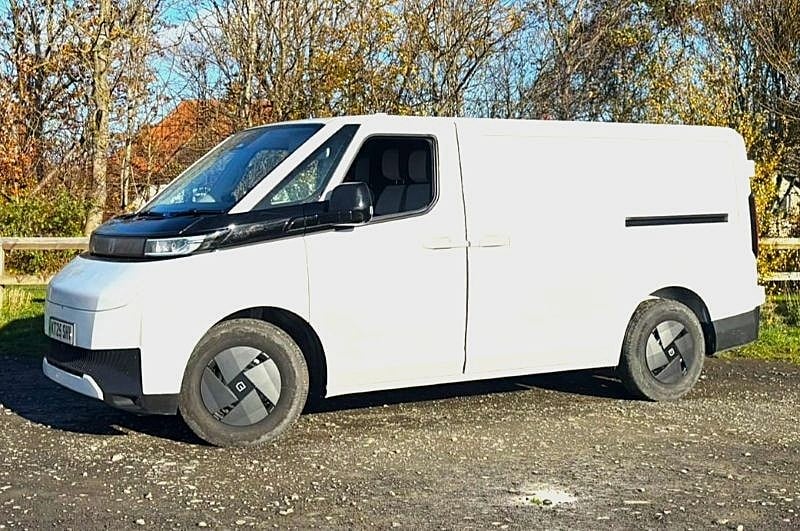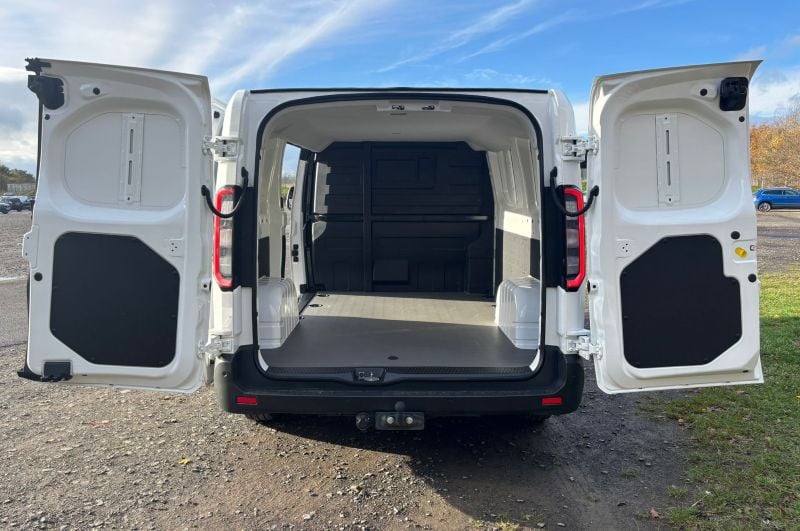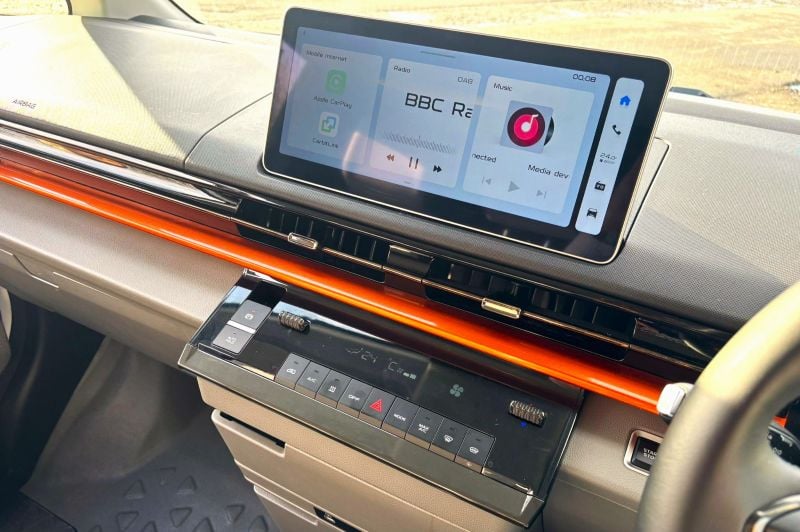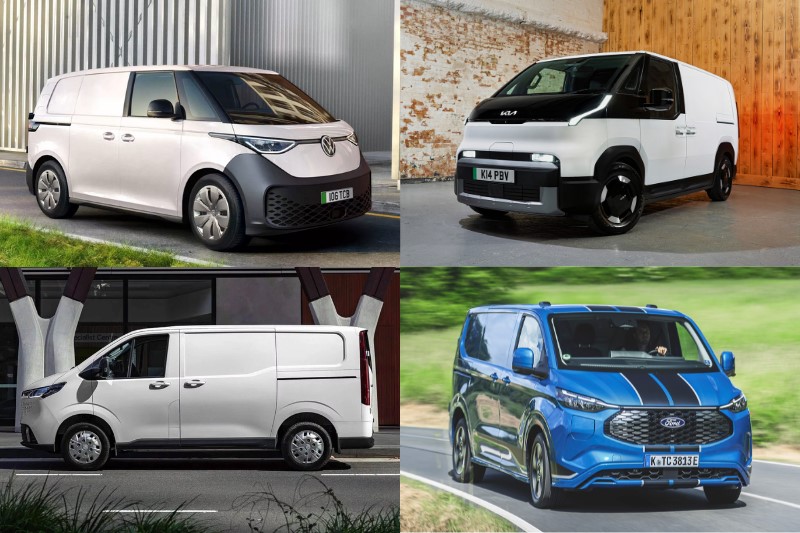Farizon the Prize: 2026 Farizon SV Review

Electric motoring might be all the rage right now, but it’s fair to say ‘EV fever’ hasn’t quite reached the commercial vehicle market� at least, not yet – but could this all change thanks to the Farizon SV, an intriguing new van that claims electric power works to its practical advantage?
Model as Tested: Farizon SV 83kWh L1/H1
Power: 83kWh (Electric)
In a commercial vehicle market dominated by legacies stretching back decades, it takes a brave company to go to the effort and expense of trying to muscle into the line of sight of businesses when new van time comes around again.
Indeed, with pedigree models like the Ford Transit, Volkswagen Transporter and Mercedes-Benz Sprinter being veritable household (business-hold?) names up and down the UK, any new van from unfamiliar brand has a sizeable task to book its place on any would-be shopping list.
That said, times are changing as demonstrated in the passenger car market where a swathe of Chinese brands, most notably BYD, Omoda and Jaecoo among many others, have arrived en masse to gobble up a chunky slice of the UK market share in just a couple of years
Predictably, attention in China has now turned to the UK van sector leading to the arrival of Farizon, the commercial vehicle arm of Geely. And perhaps even more predictably, its maiden effort – the Farizon SV - is electric.
A choice of three batteries and five body sizes – L1/H1 up to L3/H3 - earns it an entry into both the medium and large van sectors, putting the Farizon SV right into the crosshairs of both the Ford E-Transit Custom and Ford E-Transit.
That’s some mighty competition right there, so to find out if the Farizon SV is the answer to those lingering (electrically) charged questions, Vansdirect hit the road in an L1/H1 83kWh model to find out...

Solving the Electric Van Conundrum
Being EV only is a bold move considering the lukewarm uptake of electric vans right now (less than ten per cent of the entire market) despite more than 40 models being readily available.
However, these are mostly vans developed around a conventional diesel engine that have been repurposed with a (heavy, sub-optimally packaged) battery, leading to a delicate balance of compromise between GVW, payload, towing ability and range.
It’s a dilemma of priorities most brands haven’t quite solved yet – some sacrifice payload for more range, others take the opposite approach.
However, progress is evolving at a rapid rate and Farizon – having developed the SV exclusively around its battery unit – is confident that designing a conventional-looking van around a dedicated EV platform is its solution to that conundrum.

Is the Farizon SV a Good Van? – The Direct Verdict
It would have been easy for Farizon to tout the SV solely around the lower running costs that come with it being an electric van, but instead it is the amount of thought that has gone into maximising its primary selling point that leaves the biggest impression. For one, the SV demands few – if any – compromises in terms of payload, the technology is en pointe and the intricate packaging endows it some genuine practical advantages over its rivals. Some quirky idiosyncrasies aside, it’s clear Farizon has done its homework... making the SV is a very strong debut effort.
Lease the Farizon SV if...
- You want to drastically reduce your running costs
- You’re after outright space and easy loading access
- You want electric power without sacrificing payload capacity
- You don’t mind catching glances from other van drivers
Lease the Farizon SV with Vansdirect
Leasing a new Farizon SV van with Vansdirect has never been easier or better value.
Get the right electric van at the right deal, fast and hassle-free with the best Farizon SV van leasing deals, across the entire electric van range.
Speak to our expert team today and you could be driving a new Farizon SV in no time with free UK mainland delivery.
So, Who Are Farizon?
While you’d be forgiven for not having heard of either Farizon or Geely, be assured this is no precocious upstart.
Farizon holds a substantial portion of the Chinese commercial vehicle market, while Geely – which coincidentally has just launched its first passenger car in the UK - ranks as one of the nation’s most successful marques.
And if you haven’t heard of Geely, you will recognise its portfolio as the owners of Volvo, Polestar, Lotus and LEVC.

Farizon SV: Dimensions, Load Bay & Practicality
The Farizon SV eschews convention straight out of the bag by being available in five body sizes – L1/H1, L1/H2, L2/H2, L3/H2 and L3/H3 – which positions it in both the medium and large van classes depending on the model.
It’s an unusual, yet arguably savvy approach that is symptomatic of the platform’s flexibility to be adapted to different sizes and body types, though for now the SV is only available in the UK as a panel van.
In terms of external dimensions, our entry-level L1/H1 model measures 4990mm in total length, which is a fingernail longer than the Citroen e-Dispatch (and assorted siblings), but comfortably shorter than both the Ford E-Transit Custom and Renault Trafic E-Tech.
In terms of height, the SV pokes in just below the magic two-metre mark required for vans to enter multi-storey car parks without scalping it. It is therefore a touch taller than its rivals, but we’ll come to that in a moment...
So far, so conventional then.
However, look closer and you’ll quickly see where the benefits of a dedicated EV platform yield practical gains.

First and foremost, there is no engine hanging off the front-end. It endows the SV with a particularly small front overhang, a profile accentuated by the blunt nose design comprising a modest bumper and a distinctive black-gloss bar housing the slim headlights and an illuminated Farizon motif.
This brings the cabin forward and while it makes the upright driving position feel a bit alien initially, you’ll appreciate the improved depth in forward visibility.
Being electric, the battery is therefore incorporated into the chassis and Farizon have gone to great lengths to maximise this as a design strength. Not only that, its drive-by-wire functionality (which we will explain later) also frees up more space.
It allows the SV to be packaged for an unusually low ride height, the benefits of which can be felt when stepping from the side or the rear, while it helps extend the load bay height too.
Not only that, Farizon has done away with a conventional B-pillar to allow the front and side-doors to meet flush. While one might consider the side of the bulkhead to be a de facto B-pillar, the design nonetheless allows for a vast 1.3m side door opening – a full 300mm larger than a Transit Custom’s.
It’s this attention to detail in the packaging that altogether adds up to this L1/H1 offering a massive 6.95 cubic metres of load bay space – which is more than a Transit Custom L2.
If that’s not enough for you, the largest L3/H3 offers 13 cubic metres of space, while the SV is one of only a handful of medium-sized vans to offer a taller H2 variant as well.

Farizon SV: Weights, Payloads & Towing
It’s worth noting at this point that electric power doesn’t generally mean an encroachment in load space – an electric Transit Custom is just as spacious as a diesel one, for instance.
However, compromises are to be felt in terms of payload capacity due to the increase in gross vehicle weight demanded by housing a battery that is heavier than an engine.
The Farizon SV’s dedicated electric platform, however, helps to strip away unnecessary retroactive conversion weight.
This SV has a gross vehicle weight of 3500kg across the board, no matter which size you choose. As such, there are diminishing returns when it comes to payload to make the L3/H3 the least plentiful, while our L1/H is most generous.
Even so, all five SV body sizes can house more than a tonne of payload, with our L1/H1 the peak of the range at 1350kg, while each model is capable of towing up to 2000kg too.
This is substantially more than other electric rivals, even less powerful or less frugal models.
As a comparison, the Ford Transit Custom 64kWh (136PS) L1/H1 tops out at 966kg, while the much smaller Volkswagen ID.Buzz Cargo 79kWh manages 707kg.
Better still, the Farizon SV does have one particularly nifty trick up its sleeve in the form of a ‘payload monitoring system’, which uses ride-height sensors to calibrate the weight of your van to ensure you don’t overload it... sometimes the simplest ideas are the best.
Farizon SV: Electric Range, Charging & Running Costs
Three batteries – 67kWh, 83kWh and 106kWh – are available, though the smallest and largest powertrains cannot be had with each body size.
The mid-range 83kWh here, however, can be mated to any body size and is expected to make up the lion’s share of the sales.
Again, Farizon keeps things simple by tuning the SV to a blanket 228bhp and 336Nm of torque across all three batteries. The variations are therefore notable in the range they return.
The 63kWh battery is aimed as urban last-mile delivery drivers at 188 miles, but our 83kWh and the 106kWh battery (which is reserved for larger body sizes) are almost evenly matched at 234 and 247 miles respectively.
From a WLTP perspective – the independent ‘harmonized’ unit of measurement for range quoted by manufacturers – the SV’s range isn’t class-leading, but it isn’t far off either.
In fact, this L1/H1 83kWh proposes just three miles more than the Peugeot E-Expert et al. while comfortably outperforming the Ford E-Transit Custom (202 miles) and current Renault Trafic E-Tech (186 miles).
Encouragingly, the Farizon SV stayed very close to its official figures in practice, managing an average of 225 miles by our calculation despite cool temperatures and plenty of stop-start traffic,
Though it should be noted it was driven largely unladen, it was reassuring to see the decrease in battery mileage syncing up with the increase on the odometer, even across a variety of roads.
There are three driving modes to help eke out that mileage – eco, comfort and sport - though the regenerative braking dialled into the former tends to unsettle the SV even in the briefest of moments switching from throttle to brake pedal.
It charges quickly too with Farizon claiming 36mins to go from 20-80% using a 120kW CCS socket. We put this to the test and it largely lived up its billing, taking just over ten minutes to get from 50% to 75%.
It was time enough to stop for a chat with a Vauxhall Vivaro Electric driver who’d parked up next to me and taken a shine to the unfamiliar wheels.
After correctly guessing it was Chinese, he concluded he was impressed by what he saw, though it remains to be seen whether his view was shared by the dozens of other van drivers on the road casting curious glances in my direction during our stint with the SV.
Being electric, the Farizon SV is of course eligible for the government’s Plug-in Van Grant (PiVG) which slashes up to £5,000 off its list price until at least 2027.

Farizon SV: Performance & Driving
While large vans are never going to be the last word in entertainment, the Farizon SV tackles the challenges posed by the UK’s rutted roads better than you might expect for a first attempt.
Much can be attributed to the SV’s trick steer-by-wire set-up, which Farizon says removes the complexities of the traditional set-up and should mean fewer components that could go wrong.
While the initial feeling is rather artificial on first touch, in part because you already feel like you’re sat almost right on top of the front wheels, you soon adapt to find it is works effectively, particularly when navigating tighter turns.
It makes the SV feel more sure-footed than anticipated, a spring in its step thrust along by the punchy 228bhp on tap. While tuned not to lurch into a surge like some electric vehicles, the SV pulls well and resists early urges to plateau the power torque curve.
At higher speeds the SV holds onto its stability well enough – though you may encounter a cacophony of various alerts and assists if you do make with some haste.
It’s nimble around town too, the SV’s short overhang allowing for a usefully compact 12.2m turning circle.
On the flip side, the ride can become jittery, which occasionally leads to it getting too close to the white lines, triggering the lane departure warning system to wrestle it back into the centre.
On the flip side, switching between drive modes calms things down a bit without taking noticeable chunks out of the estimated range even in Sport mode

Farizon SV: Cab & Interior
In a class brimming with platform sharing vans that look almost identical to at least one or more others on the market, it’s therefore refreshing to see something different upon climbing into the Farizon SV.
First impressions are positive. The dashboard is dominated by a large central screen and there is some well-judged attention to detail to lift the fuss-free design.
The bronze/orange strip certainly pops, while accents of the same colour can be found on the door handle inserts and seat stitching too.
A smattering of physical controls make a welcome appearance, though most of the functionality is handled by touchscreen, which we found to be lag-free and logical to use on the move. That said, sifting through the sheer number of settings labelled with ambiguous acronyms can be overawing.
In terms of build quality, while the lower half of the front fascia is betrayed by some hard, scratchier plastics, the chunky steering wheel and well-shaped seats give the touch points an air of quality.

Farizon SV: Specifications, Equipment & Trims
While there is just a single trim level available across the entire range, the Farizon SV is generously kitted out.
Technology and smart connectivity are the priority here, with the SV feeling every inch a modern van through and through.
Standard features of the Farizon SV include:
- Air-conditioning
- Ventilated and heated driver/outer passenger seat
- 4-way manual adjustable seat
- Multifunction steering wheel
- Heated steering wheel
- Anchor points
- Apple CarPlay/Android Auto
- Bluetooth function
- Automatic LED headlights
- Electric windows
- Electric mirrors
- Automatic rain sensing wipers
- Heated windscreen
- Weight monitoring system
- Central locking with four-door anti-theft
- Keyless start-
- ABS
- Driver/passenger airbag
- Tyre pressure monitoring
- Front/rear parking radar
- Rear cross traffic alert (RCTA)
- Lane change assist (LCA)
- Lane Departure Warning System (LDWS)
- Driver monitoring system
- 360-degree around view
- Blind spot detection
- Predictive and forward collision warning
- Autonomous emergency braking
Farizon SV: Reliability
As an all-new brand for the UK, it’s a case of wait and see for a few more Farizon SVs to be criss-crossing the country on a regular basis before determining whether it will live up to a reliable reputation.
While we only have Farizon’s word to go on for now, the manufacturer has at least signalled confidence in its van by offering a 4-year/120,000-mile warranty, plus an 8-year battery warranty.
It means the SV has one of the more generous aftersales packages in the medium or large van class.
Farizon SV: Safety & Security
The Farizon SV achieved a maximum five-star EuroNCAP during a round of tests assessing the effectiveness of its crash avoidance safety systems.
The SV scored 85% for crash avoidance, 80% for post-crash safety and 60% for safe driving, earning it five-stars overall.

Farizon SV: FULL VERDICT
More than anything, the Farizon SV is a good example of just what is possible for electric vans. The dedicated EV platform gives the SV more flexibility with packaging and is responsible for ensuring an impressive payload and allowing for a particularly vast load bay.
On the road, the SV feels powerful without eating away at the mileage range, while rapid recharging should mean minimal downtime.
If you’re already convinced electric is the way to go for your business, the Farizon SV should be added to your list of candidates.
And if you still need some convincing, then the SV could be the electric van to change your perceptions...

How Does the Farizon SV Compare to Rivals?
|
|
Farizon SV 83kWh L1 H1 |
VW ID.Buzz Cargo 79kWh Commerce |
Kia PV5 Cargo 71kWh Long Range L2 H1 |
Maxus eDeliver 7 77kWh L1 H1 |
Ford E-Transit Custom 64kWh 136PS L1 H1 |
|
Powertrain |
Electric |
Electric |
Electric |
Electric |
Electric |
|
Capacity |
83kWh |
79kWh |
71kWh |
77kWh |
64kWh |
|
Max Power |
228bhp |
282bhp |
161bhp |
202bhp |
182bhp |
|
Max Torque |
336Nm |
550Nm |
250Nm |
330Nm |
415Nm |
|
Range [WLTP Combined] |
234 miles |
277 miles |
247 miles |
201 miles |
198 miles |
|
CO2 [WLTP] |
0g/km |
0g/km |
0g/km |
0g/km |
0g/km |
|
Recharge |
36mins (20-80%) |
30mins (5-80%) |
30mins (10-80%) |
43mins (20-80%) |
39mins (10-80%) |
|
Length |
4990mm |
4712mm |
4695mm |
4998mm |
5050mm |
|
Height |
1980mm |
1937mm |
1923mm |
1990mm |
1659mm |
|
Wheelbase |
3100mm |
2989mm |
2995mm |
3000mm |
3100mm |
|
Load Volume |
6.95cu m |
3.9cu m |
4.4cu m |
5.9cu m |
5.7cu m |
|
Maximum Payload |
1350kg |
707kg |
690kg |
1200kg |
966kg |
|
Towing Capacity [Braked] |
2000kg |
1200kg |
750kg |
1500kg |
2250kg |
|
Gross Vehicle Weight |
3500kg |
3150kg |
2650kg |
3500kg |
3225kg |

















